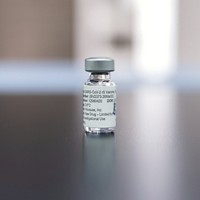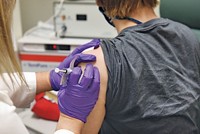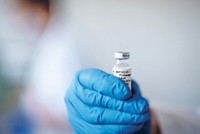Advertisement
Grab your lab coat. Let's get started
Welcome!
Welcome!
Create an account below to get 6 C&EN articles per month, receive newsletters and more - all free.
It seems this is your first time logging in online. Please enter the following information to continue.
As an ACS member you automatically get access to this site. All we need is few more details to create your reading experience.
Not you? Sign in with a different account.
Not you? Sign in with a different account.
ERROR 1
ERROR 1
ERROR 2
ERROR 2
ERROR 2
ERROR 2
ERROR 2
Password and Confirm password must match.
If you have an ACS member number, please enter it here so we can link this account to your membership. (optional)
ERROR 2
ACS values your privacy. By submitting your information, you are gaining access to C&EN and subscribing to our weekly newsletter. We use the information you provide to make your reading experience better, and we will never sell your data to third party members.
Vaccines
Covid-19
CanSino publishes first COVID-19 vaccine data to muted response
The Chinese vaccine company is pushing ahead with clinical trials in China and Canada, despite mixed results from its Phase I study
by Ryan Cross
May 28, 2020
| A version of this story appeared in
Volume 98, Issue 21

On March 16, China’s CanSino Biologics became the world’s first company to begin a clinical study of a vaccine designed to protect against infections of SARS-CoV-2, the novel coronavirus that causes COVID-19. Less than 10 weeks later, the company has achieved another first in the global vaccine race: publication of peer-reviewed data assessing the safety and immunogenicity of a COVID-19 vaccine.
CanSino’s vaccine uses a genetically engineered adenovirus, called an adenoviral vector, to deliver the gene that encodes the SARS-CoV-2 spike protein into human cells. SARS-CoV-2 uses that protein to infect cells. Scientists hope spike proteins generated from the vaccine will give our immune systems some target practice so we can quickly halt an infection of the real virus.
In the firm’s Phase I safety study, 108 people got one of three doses of the vaccine. Most people developed immune responses, as measured by the levels of antibodies and T cells that target the spike protein.
Support nonprofit science journalism
C&EN has made this story and all of its coverage of the coronavirus epidemic freely available during the outbreak to keep the public informed. To support us:
Donate Join Subscribe
But scientists make a distinction between antibodies that simply bind to the spike protein and those that prevent infection—so-called neutralizing antibodies. They believe that developing neutralizing antibodies is a crucial step our bodies must take to prevent the virus from gaining a foothold in the first place.
CanSino measured the concentrations of neutralizing antibodies that prevented the virus from infecting human cells grown in a dish. Only 75% of people who received the high dose and 50% of people who received a medium or low dose of the vaccine developed levels of neutralizing antibodies deemed high by the researchers (Lancet 2020, DOI: 10.1016/S0140-6736(20)31208-3).
No one knows what levels of neutralizing antibodies are needed to protect from SARS-CoV-2 infection, explains Dennis Burton, an immunologist at Scripps Research, but the levels induced by CanSino’s vaccine “are not overwhelming by any means at all.”
“It is not great, but it is better than nothing,” says Hildegund C.J. Ertl, a scientist who develops and studies adenoviral vector vaccines at the Wistar Institute in Philadelphia. She says the antibody responses are “a little disappointing,” particularly in the oldest participants in the study, aged 45-60, who were less likely to develop neutralizing antibodies.
There’s another problem. CanSino’s adenoviral vector vaccine is based on Ad5, a prevalent adenovirus that causes the common cold. Many people previously infected with Ad5 have high levels of neutralizing antibodies that target Ad5—including about half the people in CanSino’s study. These participants were less likely to have strong antibody responses to the vaccine.
Higher doses of the vaccines can overcome the Ad5 neutralizing antibodies. But Ertl warns that high doses of adenoviral vectors can be toxic. “And they were pushing the limit,” she says. CanSino decided to drop the high dose due to safety concerns. The low and medium doses are being compared to a placebo in the company’s ongoing Phase II study of 500 people, which began in April.
Most people, 81%, experienced at least one major side effect to the vaccine, such as headache, muscle pain, fatigue, fever, and muscle pain. Although some reactions are to be expected from an adenoviral vector vaccine, Ertl says, a concerning 9 people developed severe fevers, including 5 who received the high dose of the vaccine.
Scientist and investor response to CanSino’s study was muted, particularly compared to Moderna’s COVID-19 vaccine announcement on May 18. The Cambridge, Massachusetts-based biotech firm said all 45 people in its study developed antibodies against the virus after vaccination, and that the 8 people it had tested so far had neutralizing antibodies. The news captured headlines and lifted Moderna’s stock but was also lambasted by scientists because the company did not release any data.
“China was the first to publish. That’s something that we should take very seriously,” says Brad Loncar, CEO of Loncar Investments and creator of a Chinese biotech investment fund. “More than any other country, they want to win the vaccine race.”
In 2017, the Chinese government approved CanSino’s Ad5-based Ebola vaccine, for emergency use and national stockpiling only. The vaccine was only tested in a Phase II study and not a large Phase III study, which regulators typically require to prove efficacy. “It is a sign of China’s independence when it comes to stuff like this,” Loncar says.
Today, no adenoviral vector vaccines are proven to work in humans. The only such vaccine approved outside of China is used by the Canadian government to prevent the spread of rabies in wild animals. The National Research Council of Canada, which helped manufacture the rabies vaccine, recently said it would begin manufacturing CanSino’s COVID-19 vaccine.
Clinical trials of that vaccine are expected to begin soon in Canada, which would make it the most advanced COVID-19 vaccine program in that country.
Among other companies developing adenoviral vector vaccines for COVID-19, ImmunityBio says it uses a version of Ad5 engineered to circumvent the problem of pre-existing immunity. The company recently announced that it was selected to participate in Operation Warp Speed, the US government initiative to develop and manufacture hundreds of millions of COVID-19 vaccines before the end of the year. ImmunityBio expects the first clinical trial of its vaccine to begin in June.
The US government is also funding two other adenoviral vector vaccines that use alternatives to Ad5. Johnson & Johnson is developing a vaccine using Ad26, a less prevalent adenovirus. AstraZeneca is developing a vaccine designed and tested by scientists at the University of Oxford. It uses an adenovirus that normally infects chimpanzees but not humans.
These vaccines are designed to avoid Ad5 neutralizing antibodies, which Ertl warns will likely dampen the effectiveness of CanSino’s vaccine in many parts of the world. About 50% of people in the US, and 80 to 90% of people in some parts of Africa, have high levels of Ad5 neutralizing antibodies. Fewer people have neutralizing antibodies to Ad26, though about 50% of people in parts of sub-Saharan Africa and Southeast Asia do.
Ertl is optimistic that Oxford’s vaccine will not face these problems. “Most people don’t have neutralizing antibodies to chimpanzee adenoviruses.”
Still, some observers say CanSino’s vaccine could still be useful for slowing the pandemic. “There may be a big market for this in younger and healthier people,” Loncar says. “I wouldn’t say this was a grand-slam home run, but I wouldn’t write it off either. The best way to describe this is mixed.”





Join the conversation
Contact the reporter
Submit a Letter to the Editor for publication
Engage with us on Twitter